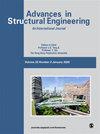Insight into the peristaltic motion through a tapered channel with Newton’s cooling subject to viscous dissipation, Lorentz force, and velocity slip
IF 2
4区 工程技术
引用次数: 0
Abstract
Peristalsis has gained significant attention due to its numerous applications in the medical field, engineering, and manufacturing industries. Therefore, the current work intends to look into the effects of variable liquid properties on the magnetohydrodynamics of peristaltic flow exhibited by viscous fluid through a tapered channel. The viscosity of the liquid differs over the thickness of the channel, and temperature-dependent thermal conductivity is considered. The constitutive relation for energy is formulated with the addition of viscous dissipation and heat generation/absorption. The assumption of velocity slip along with the convective boundary condition energizes the thermal system as well as the flow phenomena. The mathematical formulation is established on the grounds of low Reynolds number and long wavelength approximations. Perturbation solution were obtained for the resulting non-linear differential equations of momentum and energy for small values of variable viscosity and variable thermal conductivity. The effects of various relevant parameters on flow properties were investigated through graphical analysis. The results show that the maximum velocity does not occur in the middle of the tapered channel, but moves toward the upper wall with the increase in the variable viscosity difference between the walls. The application of viscosity is essential in many engineering and industrial processes.在牛顿冷却作用下,受粘性耗散、洛伦兹力和速度滑移的影响,通过锥形通道的蠕动运动的深入研究
蠕动因其在医疗领域、工程和制造业的大量应用而备受关注。因此,目前的工作旨在研究液体特性的变化对粘性流体通过锥形通道时表现出的蠕动流的磁流体动力学的影响。液体的粘度随通道的厚度而变化,并考虑了与温度相关的热导率。在制定能量构成关系时,增加了粘性耗散和热量产生/吸收。速度滑移假设和对流边界条件为热系统和流动现象提供了能量。数学公式建立在低雷诺数和长波长近似的基础上。针对可变粘度和可变热导率的小数值,对由此产生的动量和能量非线性微分方程进行了扰动求解。通过图形分析研究了各种相关参数对流动特性的影响。结果表明,最大流速并不是出现在锥形通道的中间,而是随着两壁之间可变粘度差的增加而向上部移动。在许多工程和工业流程中,粘度的应用至关重要。
本文章由计算机程序翻译,如有差异,请以英文原文为准。
求助全文
约1分钟内获得全文
求助全文
来源期刊

Advances in Mechanical Engineering
Engineering-Mechanical Engineering
自引率
4.80%
发文量
353
期刊介绍:
Advances in Mechanical Engineering (AIME) is a JCR Ranked, peer-reviewed, open access journal which publishes a wide range of original research and review articles. The journal Editorial Board welcomes manuscripts in both fundamental and applied research areas, and encourages submissions which contribute novel and innovative insights to the field of mechanical engineering
 求助内容:
求助内容: 应助结果提醒方式:
应助结果提醒方式:


